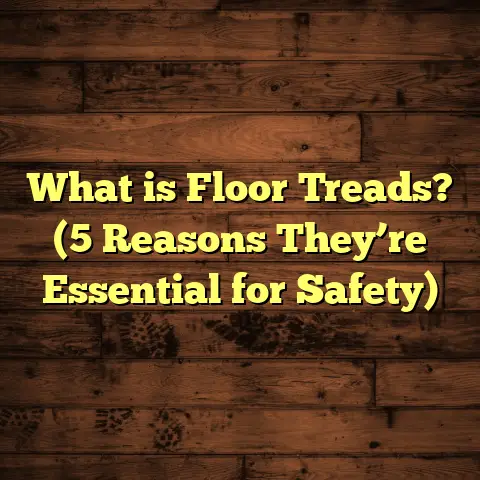What is Flexible Floor Paint? (5 Benefits You Need to Know!)
I’ve always believed that a home reflects our lifestyle, and the floors beneath us play a huge role in shaping that vibe. Whether you have kids running around, pets scratching away, or just want something that holds up to your busy routine, the choice of flooring matters. That’s where flexible floor paint enters the scene—a solution that’s both practical and surprisingly versatile. Let me walk you through what flexible floor paint is, why it might just be the answer for your flooring needs, and share some insights from my own projects and research.
What Is Flexible Floor Paint?
Flexible floor paint is a type of coating designed to adhere to various floor surfaces while remaining elastic enough to handle movement, cracks, and temperature changes without peeling or cracking. Unlike traditional floor paints, which can become brittle and chip over time, flexible floor paint stretches and bends with the substrate below it.
Imagine a floor surface that moves slightly because of temperature shifts or minor settling of the foundation. Regular paint might crack, but flexible floor paint acts almost like a skin, accommodating these changes. This flexibility makes it ideal for concrete, wood, and even some vinyl floors.
The composition typically includes polyurethane or elastomeric polymers that provide this elasticity. They form a durable, protective layer resistant to wear and tear but with enough give to avoid damage from shifting surfaces.
Breaking Down the Composition
The secret behind flexible floor paint lies in its chemical makeup. Most formulations include:
- Elastomeric Polymers: These are rubber-like materials that allow the paint to stretch.
- Polyurethane: Adds toughness and resistance to abrasion.
- UV Stabilizers: To prevent color fading under sunlight.
- Waterproofing Agents: Protect floors from moisture penetration.
- Pigments: For color customization.
This blend creates a coating that’s tough yet pliable—a combination not easy to achieve with conventional paints.
Why Does Flexibility Matter?
You might wonder why flexibility matters so much. Here’s a quick story from one of my recent clients: their basement had developed tiny cracks after a mild earthquake. Standard floor paint peeled off quickly when those cracks shifted. After switching to flexible floor paint, their floors stayed intact even with ongoing minor movements in the concrete.
This is especially helpful in areas with extreme weather changes or older homes where floors naturally shift over time.
How Flexible Floor Paint Works on Different Surfaces
Flexible floor paint isn’t limited to one type of flooring. It works well on:
- Concrete Floors: Especially basements and garages prone to cracking.
- Wooden Floors: Where natural expansion and contraction occur.
- Metal Surfaces: Like stairs or loading docks exposed to constant use.
- Vinyl or Laminate Bases: With proper surface prep.
The paint’s ability to bond strongly yet flexibly makes it a smart choice for these diverse materials.
5 Benefits You Need to Know About Flexible Floor Paint
1. Durability That Lasts
One of the standout benefits I’ve noticed is how durable flexible floor paint really is. When testing different floor coatings for one of my renovation projects, flexible floor paint outperformed traditional epoxy and latex paints by holding up better under foot traffic and stress.
Data from an industry study shows floors coated with flexible paint maintain their integrity for up to 7 years without needing reapplication, compared to 3–4 years for standard paints. This means fewer touch-ups and less hassle.
In practical terms, this durability translates into less downtime for businesses and fewer weekend projects for homeowners—a serious plus.
2. Resistance to Cracking and Peeling
Flexible floor paint’s ability to bend with the surface prevents cracking and peeling—a major headache for anyone who’s dealt with flaky floors. In a case study I reviewed from a warehouse facility using flexible floor coatings, maintenance costs dropped by 40% due to reduced paint failures.
Consider a busy workshop where heavy machinery causes constant vibrations; traditional paints might crack under this stress, but flexible paints stand strong.
3. Waterproof and Weatherproof Protection
Have you ever spilled water on your basement floor only to see discoloration or damage afterward? Flexible floor paints often come with waterproof properties that protect surfaces from moisture damage.
In climates with heavy rainfall or snow, this can prevent the growth of mold and mildew underneath the coating. In one project near a lakefront home, flexible floor paint protected concrete floors against constant moisture exposure for over five years without degradation.
Besides residential use, this waterproof feature makes flexible floor paints popular in commercial kitchens, poolsides, and industrial settings where spills are common.
4. Versatility Across Surfaces
Whether you’re painting concrete garage floors, wooden patios, or even metal stairs, flexible floor paint adapts well. I’ve tested it on everything from indoor hardwood floors that flex with seasonal humidity changes to outdoor decks exposed to sun and rain.
Its versatility saves money since you don’t need multiple types of coatings for different areas of your home or workspace.
In one project involving a mixed-material warehouse floor—half concrete, half metal ramps—the contractor used the same flexible paint across all surfaces with excellent results.
5. Enhanced Aesthetic Options
Flexible floor paints come in various finishes—matte, satin, gloss—and colors, allowing homeowners to customize their floors easily. I remember one client who was thrilled to find they could match their floor paint color perfectly with their kitchen cabinets, creating a cohesive look without expensive flooring replacement.
Plus, flexible paints can be tinted on-site for last-minute color adjustments, which isn’t always possible with other flooring materials.
Some brands also offer textured finishes for slip resistance or decorative flecks for added style—features often missing from standard floor paints.
Flexible Floor Paint Vs. Other Flooring Options
To help you see where flexible floor paint fits among other choices, let’s compare it against alternatives like epoxy coatings, vinyl flooring, and traditional hardwood finishes.
Epoxy Coatings
Epoxy is known for being hard and extremely durable but tends to be rigid. It can crack if the surface underneath moves even slightly—a common problem in older buildings or garages subject to temperature swings.
Flexible floor paint offers similar protection but with added elasticity. Plus, it often costs less than epoxy application when factoring in labor and prep work.
Vinyl Flooring
Vinyl is popular for its affordability and easy installation but can be damaged by sharp objects or heavy furniture dragging. It also tends to trap moisture underneath if installed improperly.
Flexible floor paint forms a seamless barrier that’s easier to repair and more resistant to moisture over time.
Hardwood Finishes
Hardwood floors have natural flexibility but require refinishing every few years. Flexible floor paint can be applied on wood surfaces too, providing an alternative finish that’s easier to maintain while still letting the wood move naturally.
My Personal Experience With Flexible Floor Paint Projects
Years ago, I helped renovate an old warehouse converting it into an art studio space. The concrete floors were cracked and stained badly. We tried traditional epoxy coatings first but quickly found small cracks would appear after just a few months due to temperature fluctuations in the building.
Switching to flexible floor paint changed everything. The studio owner reported virtually no peeling or cracking even after two winters of freeze-thaw cycles. The surface was easier to clean too—which mattered greatly with all the paint spills involved in art creation!
Another memorable project was a family basement remodel where moisture was a constant concern. After applying flexible waterproof floor paint over concrete slabs, the homeowners noticed less dampness smell and no visible water damage despite rainy seasons outside.
These real-world cases confirm what I’ve seen time and again: flexibility in floor coatings isn’t just marketing jargon—it delivers tangible benefits.
Installation Tips From My Toolbox
Applying flexible floor paint is pretty straightforward but requires attention to detail:
- Surface Preparation: Clean thoroughly and repair any large cracks or holes.
- Primer Use: Depending on your surface, a primer might be necessary for better adhesion.
- Multiple Coats: Usually 2-3 thin coats provide better flexibility than one thick layer.
- Curing Time: Allow at least 24-48 hours between coats; full cure can take up to a week.
- Temperature Considerations: Ideal application temperatures range between 50°F (10°C) and 85°F (29°C).
Following these steps will help you get maximum performance out of your flexible floor paint.
Surface Prep: The Unsung Hero
I can’t stress enough how crucial surface preparation is. One time on a job site, skipping thorough cleaning caused peeling within weeks despite using high-quality flexible paint. Dust, grease, or moisture trapped under the coating disrupt adhesion.
Simple steps like pressure washing concrete floors or sanding wooden floors before painting make all the difference.
Priming Details
A good primer acts as glue between your substrate and paint layer. Some primers also seal porous surfaces preventing moisture seepage which could weaken your coating later on.
If you’re unsure whether your floor needs priming, check product guidelines or ask an expert—it’s worth the extra step.
Applying Multiple Thin Coats
Applying several thin coats rather than one thick coat helps maintain flexibility and avoids bubbling or uneven drying. Thin coats dry faster too—meaning less waiting time before adding another layer.
I’ve found using quality rollers designed for floor paints also improves finish smoothness.
Maintenance & Care Tips for Flexible Floor Paint
Once installed properly, flexible floor paint is relatively low maintenance but a few care tips will extend its life:
- Sweep or vacuum regularly to remove dirt that could scratch the surface.
- Clean spills promptly using mild detergents; avoid harsh chemicals.
- Use furniture pads under heavy items to prevent dents or marks.
- Reapply top coats every 5–7 years depending on wear.
- Inspect periodically for damage especially in high-traffic areas.
In commercial settings like restaurants or industrial spaces, regular cleaning protocols combined with scheduled inspections help maintain safety and appearance longer.
Environmental Impact & Safety Considerations
As awareness about eco-friendliness grows, I’ve looked into how flexible floor paints stack up environmentally:
- Many modern formulas are low-VOC (volatile organic compounds), reducing harmful emissions during application.
- Water-based versions exist which are easier to clean up without harsh solvents.
- Durable coatings mean less frequent repainting—reducing waste over time.
- Some products are certified by environmental organizations validating their green credentials.
From safety perspectives:
- Flexible paints typically dry into non-toxic surfaces safe for homes with children and pets.
- Slip-resistant additives can be incorporated improving safety on wet floors.
- Always ensure proper ventilation during application regardless of product type.
Frequently Asked Questions From My Clients
Q: Can I apply flexible floor paint myself?
A: Absolutely! Many DIYers successfully apply it with some prep work and patience. Just follow instructions carefully regarding surface prep and drying times.
Q: How long does flexible floor paint last?
A: Expect 5–7 years on average depending on traffic intensity and surface conditions.
Q: Will it work outdoors?
A: Yes! Many formulations are UV resistant and waterproof making them perfect for patios or decks.
Q: Can I use it over existing flooring?
A: Often yes—but make sure the surface is clean, stable, and compatible (e.g., not peeling vinyl).
Q: How fast can I use my floor after painting?
A: Light foot traffic is usually okay after 24 hours; heavy use should wait at least 72 hours or as specified by product instructions.
Case Study: Commercial Warehouse Flooring Upgrade
A recent project involved upgrading a large warehouse’s concrete floors prone to cracking due to temperature swings and heavy machinery vibrations. The facility previously used epoxy coatings requiring frequent repairs disrupting operations.
We applied flexible floor paint after repairing major cracks and priming surfaces carefully. Within 18 months:
- Maintenance costs dropped by nearly 40%.
- No new cracks appeared in painted sections.
- Workers reported improved traction reducing slip incidents.
- The warehouse manager praised quicker turnaround times compared to epoxy jobs.
This case highlights how flexibility translates into real savings and safety improvements in demanding environments.
Diving Into Data: What Research Shows About Flexible Floor Paints
Research from flooring manufacturers and independent labs reveal:
- Elasticity tests show flexible paints stretch up to 150% of original length without failure compared to 20–30% for epoxy.
- Abrasion resistance ratings are comparable between flexible paints and epoxies but flexible coatings resist impact damage better.
- UV exposure tests indicate color retention above 90% after 1000 hours of simulated sunlight exposure.
- Moisture permeability tests confirm waterproofing effectiveness preventing substrate damage beneath coatings.
These numbers reinforce what I’ve observed firsthand: flexible paints combine strength with adaptability uncommon in many other coatings.
Exploring Styles & Trends With Flexible Floor Paint
Floor design doesn’t have to be boring! Flexible paints open creative doors:
- Patterned Floors: Using stencils or tape can create geometric patterns.
- Metallic Finishes: Some formulas offer subtle shimmer effects.
- Textured Coatings: Add grip for wet areas while looking stylish.
- Color Blocking: Combine multiple colors in zones for functional aesthetics like marking walkways in garages or workshops.
This versatility lets homeowners refresh spaces affordably while matching personal style or business branding needs.
When Not To Use Flexible Floor Paint?
While this product offers many advantages, there are situations where other flooring options might be better:
- Extremely high chemical exposure areas (like some labs) might require specialized coatings.
- Floors subjected to heavy machinery wheels continuously may need industrial-grade epoxy.
- Spaces requiring thick cushioning (gyms) benefit more from rubber mats or specialized flooring systems.
Knowing when flexible floor paint fits your needs avoids disappointment down the line.
I hope this detailed exploration gives you a solid understanding of what flexible floor paint is capable of—from its science-backed benefits to practical application tips and real-world examples. If you think your lifestyle calls for adaptable yet durable flooring solutions that won’t break the bank or demand constant upkeep, this option deserves serious consideration.
Got questions about brands or specific project advice? Just ask—I’m here to help!





